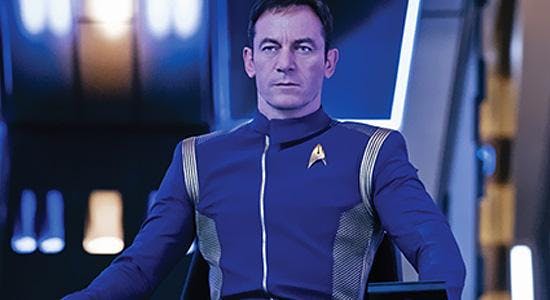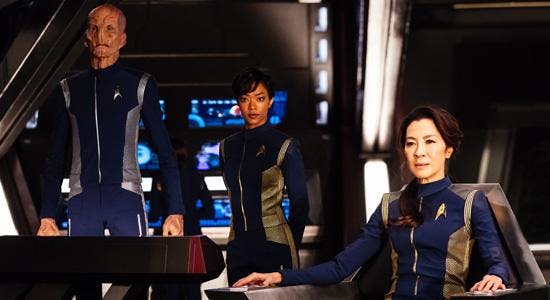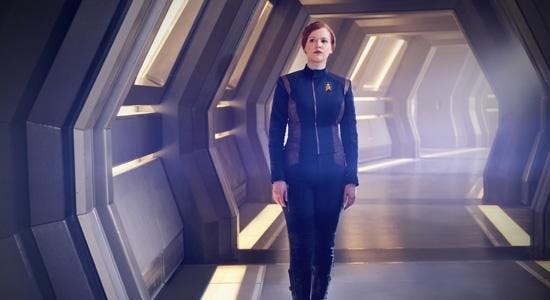
Stardate: August 21, 2017.
On this day, all across North America, millions of people trained their eyes on the skies above, as they checked out the rare total eclipse. Meanwhile, over at Pinewood Studios in Toronto, Canada, a couple of dozen journalists from outlets worldwide – including yours truly from StarTrek.com -- happily missed the eclipse in order to experience something even more infrequent: a visit to the sets of the upcoming Star Trek: Discoveryseries.
Now, let me put this in some perspective. Over the years, for New York Times Syndicate, Starlog, the official Deep Space Nine and Voyager magazines, as well as Star Trek Monthly, I’ve had the honor of visiting the sets of The Voyage Home, TNG, DS9, Voyager, Enterprise, Generations, First Contact, Insurrection and Nemesis. My visit to The Voyage Home set will never, ever be beat, as it was the day the cast and crew transformed the parking lot at Paramount into the San Francisco Bay, wind and lightning machines crackled and whirred, and Leonard Nimoy stood, in a white robe, megaphone in hand, orchestrating the chaos like a conductor as Shatner, Kelley, Takei, Nichols, Doohan, Koenig and Catherine Hicks stepped off a Klingon Bird-of-Prey and into the drink. That was pure, old-school Hollywood magic. I’d not visited the set of any of the J.J.-verse films, however, so I was stoked to see what was in store when it came to Discovery.

Aaron Harberts, Discovery's executive producer and co-showrunner, proceeded to lead our group through an informative, time-efficient, well-structured Discovery set visit experience that started with us watching a bit of filming of a scene from later in the season. All in all, the production utilizes as many as eight stages at Pinewood, including the largest one in North America. Some sets, like the mess hall, which Harberts identified as one of his favorites (because interpersonal character stories play out there) were already down, while others were being erected right as we looked on; sorry, we’re not allowed to describe those! And, for the record, Brutalist architecture dominates everything, everywhere around here. Here are some highlights:
U.S.S. DISCOVERY

The U.S.S. Discovery bridge is a sight to behold. It’s sleek and clean and shiny. Oh, and massive. Size-wise, it’s worth noting, it seemed comparable to the Enterprise-D and Voyager bridge sets, as well as more colorful/less muted than both. The centerpiece is Captain Lorca’s chair, though he apparently hardly ever sits in it. He’s a standup guy, literally, and prefers to move about and get his hands dirty. But for the sake of providing an overview, assume Lorca’s chair is dead center. Just in front of him, to his left and right, are ops stations, and right in front of them is where audiences will see a viewscreen. But don’t get too used to viewscreens. Holographic projections will be the preferred method of communicating.
Right behind Lorca’s chair, on either side, are Burnham and Saru’s stations, and further along both sides are other crew stations. At the back of the bridge, there’s a turbolift and also Lorca’s super-spartan ready room. And lit monitors on the wall reveal the current state of the Federation-Klingon war; we’re not sure, but it doesn’t seem to be going well for the good guys.
A closer examination of some of the above reveals actual buttons and knobs on the assorted consoles. Harberts referred to it as “a little bit of analog stuff.” Conversely, the transparent screens at the crew stations are uber-high-tech. They’re monitors that are actually future televisions developed by a company and soon to become available to the public. The previous sets I’d been on had nothing like it, though the J.J.-verse sets likely did. “We’re trying to bring things up just a little bit so that we were living in our present-day language or what the future's going to be bringing us,” Harberts explained, “but also continuing to sort of stay nestled in those 10 years before The Original Series.” All of the graphics are pre-programmed, so if a character interfaces with the graphics, they will either do it in time with the graphics or the graphics will be burned in later during post-production.
ENGINEERING

Anyone who has ventured up to Ticonderoga, New York, to check out The Original Series Set Tour surely marveled that the engineering room was far smaller than their imagination probably compelled them to believe. It’s the same thing up here in Toronto. Discovery's engineering section is highly functional and there’s an enclosed, well-illuminated set called a “reaction cube.” Harberts suggested keeping an eye out for the reaction cube as events on the show unfold. “Engineering is a really important set for the show,” the executive producer noted. “Burnham and Tilly are here a lot. Stamets is often on the other side.” This set, FYI, was previously utilized as a torpedo bay. I’d seen that a lot on various Trek sets in the past, as the construction crews carefully and inventively redressed sets as required by the demands of a script, budgetary concerns and/or space limitations.
U.S.S. SHENZHOU

The Shenzhou is probably a brilliant set, but our group of intrepid visitors sadly did not get to explore it. For several reasons. One, construction work was being done on it. Two, it apparently takes many steps to reach and, once you’re inside, it features several sunken areas, stations the characters/actors must step down into, and more than a few people have bonked their heads or tripped, or both. Cue the blooper reel. Three, the entire Shenzhou set is raised, as the ship’s bridge is based at the bottom of the saucer section.
From our vantage point on the ground, though, it’s worth noting that the Shenzhou set faced a huge green screen/curtain. The Shenzhou is located on stage, #8, is Discovery’s green screen stage. So, not only does the Shenzhou crew see space ahead of them courtesy of the green screen and subsequent VFX, but, for example, scenes set on Vulcan were shot in front of the green screen. Visiting this particular set reminded me of what I witnessed when I toured the First Contact sets. The Enterprise-E hull set, which would be walked on by Picard, Worf and Hawk, featured a huge green screen around and behind it, and the set pretty much filled a soundstage on its own.
“The Shenzhou feels almost more like a battle ship, even though it's a Starfleet vessel and intended for exploration, diplomacy,” Harberts said. “There's an intensity when you step onto this bridge. Not to say that Discovery isn't (intense, too), but the angles, the sharp lines, the ceiling kind of comes down to a much... The headroom there is a lot narrower. I would say it's almost more Hunt for Red October inside that bridge. It feels a little more cramped."
U.S.S. DISCOVERY CORRIDORS, TRANSPORTER & MORE

Stage #4, the aforementioned largest soundstage in North America, is home to pretty much all the major U.S.S. Discovery sets, except the bridge. There are the corridors, which are solid and feature guide lighting. The med bay is here, too, as is an airlock. So is the brig, which is, quite appropriately, a claustrophobic little space. As a veteran of Trek set visits, these all felt very familiar to me. Also here – and quite unique to anything I’d ever experienced -- was the quarters shared by Stamets and Culber. Harberts happily pointed out the bathroom and noted that the characters will share information about their respective days as they brush their teeth.

And then there's the transporter room. It’s every Trek fan’s dream to “energize,” and all of us visitors got our moment to stand on the transporter and flash the Vulcan greeting, grouse like Dr. McCoy or hum a beaming sound. This was one cool, elaborate set and, whereas the engineering room somehow felt small, this one feels enormous and wide open. I’d swear that, physically, it was bigger than I remember the transporter room sets from the various other Trek productions.
“This is another one of my favorite sets, just because it's so iconic, and it photographs so beautifully,” Harberts explained. “When you see our cast on the pads, you just can't help but get a rush. We switch this room back and forth between Discovery transporter room and Shenzhou transporter room. It's a huge switch."

"The transport technology on the Shenzhou is different, is older, quote-unquote, so you'll see a different style of transport. The shower stalls, as we call them, echo more the TOS version. But we're in here quite a bit. Off to the sides, you have lockers for EV suits, phasers, pulse rifles, things like that, for landing teams.”
So, while a set is a set is a set, the Discovery sets were mighty impressive. They’re also highly, highly detailed, as HD cameras and HD televisions can -- and do -- reveal so much more than ever before. And, clearly, the permanent sets have been built to last, which signals that the Discovery team is thinking far beyond season one. May the show live long and prosper.
Star Trek: Discovery will debut September 24 on CBS All Access in the U.S. and Space Channel in Canada. The series will premiere on Netflix in the rest of the world on September 25.



